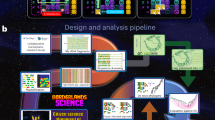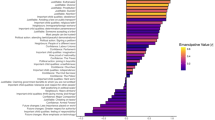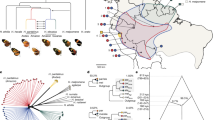Abstract
The evolution of altruism—costly self-sacrifice in the service of others—has puzzled biologists1 since The Origin of Species. For half a century, attempts to understand altruism have developed around the concept that altruists may help relatives to have extra offspring in order to spread shared genes2. This theory—known as inclusive fitness—is founded on a simple inequality termed Hamilton’s rule2. However, explanations of altruism have typically not considered the stochasticity of natural environments, which will not necessarily favour genotypes that produce the greatest average reproductive success3,4. Moreover, empirical data across many taxa reveal associations between altruism and environmental stochasticity5,6,7,8, a pattern not predicted by standard interpretations of Hamilton’s rule. Here we derive Hamilton’s rule with explicit stochasticity, leading to new predictions about the evolution of altruism. We show that altruists can increase the long-term success of their genotype by reducing the temporal variability in the number of offspring produced by their relatives. Consequently, costly altruism can evolve even if it has a net negative effect on the average reproductive success of related recipients. The selective pressure on volatility-suppressing altruism is proportional to the coefficient of variation in population fitness, and is therefore diminished by its own success. Our results formalize the hitherto elusive link between bet-hedging and altruism4,9,10,11, and reveal missing fitness effects in the evolution of animal societies.
This is a preview of subscription content, access via your institution
Access options
Access Nature and 54 other Nature Portfolio journals
Get Nature+, our best-value online-access subscription
$29.99 / 30 days
cancel any time
Subscribe to this journal
Receive 51 print issues and online access
$199.00 per year
only $3.90 per issue
Buy this article
- Purchase on Springer Link
- Instant access to full article PDF
Prices may be subject to local taxes which are calculated during checkout




Similar content being viewed by others
References
Gardner, A., West, S. A. & Wild, G. The genetical theory of kin selection. J. Evol. Biol. 24, 1020–1043 (2011)
Hamilton, W. D. The genetical evolution of social behaviour. I. J. Theor. Biol. 7, 1–16 (1964)
Starrfelt, J. & Kokko, H. Bet-hedging—a triple trade-off between means, variances and correlations. Biol. Rev. Camb. Phil. Soc. 87, 742–755 (2012)
Cockburn, A. & Russell, A. F. Cooperative breeding: a question of climate? Curr. Biol. 21, R195–R197 (2011)
Rubenstein, D. R. & Lovette, I. J. Temporal environmental variability drives the evolution of cooperative breeding in birds. Curr. Biol. 17, 1414–1419 (2007)
Jetz, W. & Rubenstein, D. R. Environmental uncertainty and the global biogeography of cooperative breeding in birds. Curr. Biol. 21, 72–78 (2011)
Kocher, S. D. et al. Transitions in social complexity along elevational gradients reveal a combined impact of season length and development time on social evolution. Proc. R. Soc. Lond. B 281, 20140627 (2014)
Sheehan, M. J. et al. Different axes of environmental variation explain the presence vs. extent of cooperative nest founding associations in Polistes paper wasps. Ecol. Lett. 18, 1057–1067 (2015)
Rubenstein, D. R. Spatiotemporal environmental variation, risk aversion, and the evolution of cooperative breeding as a bet-hedging strategy. Proc. Natl Acad. Sci. USA 108, 10816–10822 (2011)
Koenig, W. D. & Walters, E. L. Temporal variability and cooperative breeding: testing the bet-hedging hypothesis in the acorn woodpecker. Proc. R. Soc. Lond. B 282, 20151742 (2015)
Shen, S., Emlen, S. T., Koenig, W. D. & Rubenstein, D. R. The ecology of cooperative breeding behaviour. Ecol. Lett. 20, 708–720 (2017)
Griesser, M., Drobniak, S. M., Nakagawa, S. & Botero, C. A. Family living sets the stage for cooperative breeding and ecological resilience in birds. PLoS Biol. 15, e2000483 (2017)
Stevens, M. I., Hogendoorn, K. & Schwarz, M. P. Evolution of sociality by natural selection on variances in reproductive fitness: evidence from a social bee. BMC Evol. Biol. 7, 153 (2007)
Ebensperger, L. A. et al. Mean ecological conditions modulate the effects of group living and communal rearing on offspring production and survival. Behav. Ecol. 25, 862–870 (2014)
Sumner, S., Lucas, E., Barker, J. & Isaac, N. Radio-tagging technology reveals extreme nest-drifting behavior in a eusocial insect. Curr. Biol. 17, 140–145 (2007)
Lukas, D. & Clutton-Brock, T. Climate and the distribution of cooperative breeding in mammals. R. Soc. Open Sci. 4, 160897 (2017)
Grafen, A. Optimization of inclusive fitness. J. Theor. Biol. 238, 541–563 (2006)
Uitdehaag, J. C. M. Bet hedging based cooperation can limit kin selection and form a basis for mutualism. J. Theor. Biol. 280, 76–87 (2011)
Lehmann, L. & Rousset, F. The genetical theory of social behaviour. Philos. Trans. R. Soc. Lond. B 369, 1–18 (2014)
Koenig, W. D., Dickinson, J. L. & Emlen, S. T. in Cooperative Breeding in Vertebrates: Studies of Ecology, Evolution, and Behavior (eds Koenig, W. D. & Dickinson, J. L. ) 353–374 (Cambridge Univ. Press, 2016)
Bourke, A. F. G. Hamilton’s rule and the causes of social evolution. Phil. Trans. R. Soc. Lond. B 369, 20130362 (2014)
Grafen, A. Developments of the Price equation and natural selection under uncertainty. Proc. R. Soc. Lond. B 267, 1223–1227 (2000)
Dickinson, J. L. & Hatchwell, B. J. in Ecology and Evolution of Cooperative Breeding in Birds (eds Koenig, W. D. & Dickinson, J. L. ) 48–66 (Cambridge Univ. Press, 2004)
Lehmann, L. & Balloux, F. Natural selection on fecundity variance in subdivided populations: kin selection meets bet hedging. Genetics 176, 361–377 (2007)
Lande, R. Expected relative fitness and the adaptive topography of fluctuating selection. Evolution 61, 1835–1846 (2007)
Covas, R., du Plessis, M. A. & Doutrelant, C. Helpers in colonial cooperatively breeding sociable weavers Philetairus socius contribute to buffer the effects of adverse breeding conditions. Behav. Ecol. Sociobiol. 63, 103–112 (2008)
Wenzel, J. W. & Pickering, J. Cooperative foraging, productivity, and the central limit theorem. Proc. Natl Acad. Sci. USA 88, 36–38 (1991)
Rehan, S. M., Richards, M. H., Adams, M. & Schwarz, M. P. The costs and benefits of sociality in a facultatively social bee. Anim. Behav. 97, 77–85 (2014)
Lowery, N. V., McNally, L., Ratcliff, W. C. & Brown, S. P. Division of labor, bet hedging, and the evolution of mixed biofilm investment strategies. MBio 8, e00672-17 (2017)
Birch, J. The inclusive fitness controversy: finding a way forward. R. Soc. Open Sci. 4, 170335 (2017)
Acknowledgements
We thank A. Gardner for discussions in the early stages of this work, and P.K. thanks the Behaviour Discussion Group at the Smithsonian Tropical Research Institute in Panama for the opportunity to present and discuss these ideas. We thank S. Schindler, S. Okasha, B. Autzen, J. McNamara and M. Bentley for comments on the project. P.K. was supported by the National Geographic Society (GEF-NE 145-15) and a University of Bristol Research Studentship, A.D.H. by the Natural Environment Research Council (NE/L011921/1), A.N.R. by a European Research Council Consolidator Grant (award no. 682253) and S.S. by the Natural Environment Research Council (NE/M012913/2).
Author information
Authors and Affiliations
Contributions
P.K. conceived the idea, P.K. and A.D.H. performed the modelling, A.N.R. and S.S. supervised the project. All authors discussed the ideas and wrote the manuscript.
Corresponding author
Ethics declarations
Competing interests
The authors declare no competing financial interests.
Additional information
Publisher's note: Springer Nature remains neutral with regard to jurisdictional claims in published maps and institutional affiliations.
Extended data figures and tables
Extended Data Figure 1 The interaction between the frequency of altruists and the effectiveness of altruism.
a, The stochastic Hamilton’s rule predicts that selection on volatility-suppressing altruism with fixed costs and benefits can generate negative frequency dependence and is sensitive to mild mean-fecundity costs (cμ). Lower values of η denote greater buffering of recipients from the environment. We evaluate a population undergoing synchronous fluctuations to identify the frequency p* at which there is no expected change in allele frequency. We illustrate the result with individual fecundities in good years (z1) of four offspring and in bad years (z2) of one offspring. Relatedness is r = 0.5. b, Simulated population outcomes (frequency after 100,000 generations) match predictions of the stochastic Hamilton’s rule in a. Warmer colours (pink) denote higher polymorphic frequencies of altruists. In this haploid model (Supplementary Information B1-4), 1% of breeding spots are available each year for replacement by offspring that year: with such constraints on the magnitude of the response to selection, radical stochastic shifts in allele frequency over single generations do not occur, allowing the population to settle at equilibria where all alleles have equal expected relative fitness without being continually displaced (Extended Data Fig. 3). c, Competing an altruistic allele against a defector allele reveals the action of frequency-dependent selection. Here, populations experiencing costs of c = 0.2 and η = 0.466 converge to p* = 0.359 from any initial frequency (coloured lines show five starting frequencies from 0.001 to 0.999), as predicted by the stochastic Hamilton’s rule.
Extended Data Figure 2 Stochasticity as a function of bet-hedger frequency.
Stochasticity  for the model of altruistic bet-hedging in Supplementary Information B plotted against frequency (p) and cost (c) for three different values of η. a, b, When η is small, representing high levels of volatility suppression, v declines steeply with p across the range of costs. c, When η is large, the sign of the effect of p on v depends on c. Values of other parameters: z1 = 4, z2 = 1, and frequency of good years d = 0.5.
for the model of altruistic bet-hedging in Supplementary Information B plotted against frequency (p) and cost (c) for three different values of η. a, b, When η is small, representing high levels of volatility suppression, v declines steeply with p across the range of costs. c, When η is large, the sign of the effect of p on v depends on c. Values of other parameters: z1 = 4, z2 = 1, and frequency of good years d = 0.5.
Extended Data Figure 3 Weak selection negates the capacity of temporal autocorrelation to drive the frequency of altruistic bet-hedgers away from the convergence frequency.
Individual-based simulations from five different initial frequencies of an altruistic bet hedging allele (p) competing against a non-cooperator. a, The population has zero temporal autocorrelation (environmental state in each generation is random). b, The population has strong temporal autocorrelation (environmental state in the next generation has a 90% probability of remaining the same as in the current generation). Despite higher amplitude fluctuations, this population converges to the same point (from the five different starting frequencies) as the uncorrelated population (a). c, The same population is simulated with greater gene frequency changes (10% of the resident genotype frequencies are available to change each generation). The population is repeatedly carried to frequencies far from the convergence point. In this case, the utility of the stochastic Hamilton’s rule is both identifying whether a given trait is immune from invasion by competitors, and identifying the expected generational change at each frequency p. Parameters are z1 = 4, z2 = 1, r = 0.5.
Supplementary information
Supplementary Information
This file contains Supplementary Information Appendices A-C. Appendix A contains derivations of the main text equations. Appendix B contains information on obtaining benefits and costs and Appendix C provides illustrative examples. These three appendices are merged into a single .pdf file. (PDF 1089 kb)
Supplementary Data
This file contains Supplementary Appendix D1, the MATLAB code for simulation detailed in Appendix B. (TXT 5 kb)
Supplementary Data
This file contains Supplementary Appendix D2, the MATLAB code for simulation detailed in Appendix C. (TXT 17 kb)
Rights and permissions
About this article
Cite this article
Kennedy, P., Higginson, A., Radford, A. et al. Altruism in a volatile world. Nature 555, 359–362 (2018). https://doi.org/10.1038/nature25965
Received:
Accepted:
Published:
Issue Date:
DOI: https://doi.org/10.1038/nature25965
This article is cited by
-
Testing the environmental buffering hypothesis of cooperative breeding in the Seychelles warbler
acta ethologica (2023)
-
Comparative metagenomics reveals expanded insights into intra- and interspecific variation among wild bee microbiomes
Communications Biology (2022)
-
Cooperation among unrelated ant queens provides persistent growth and survival benefits during colony ontogeny
Scientific Reports (2021)
Comments
By submitting a comment you agree to abide by our Terms and Community Guidelines. If you find something abusive or that does not comply with our terms or guidelines please flag it as inappropriate.



